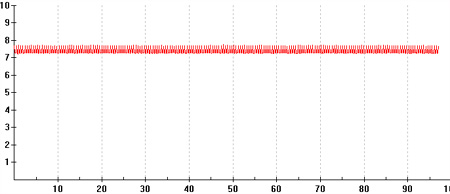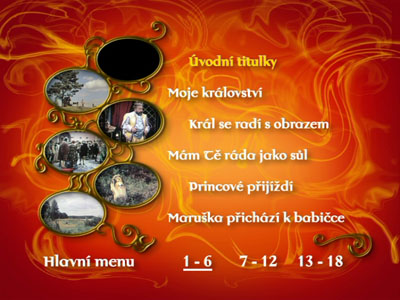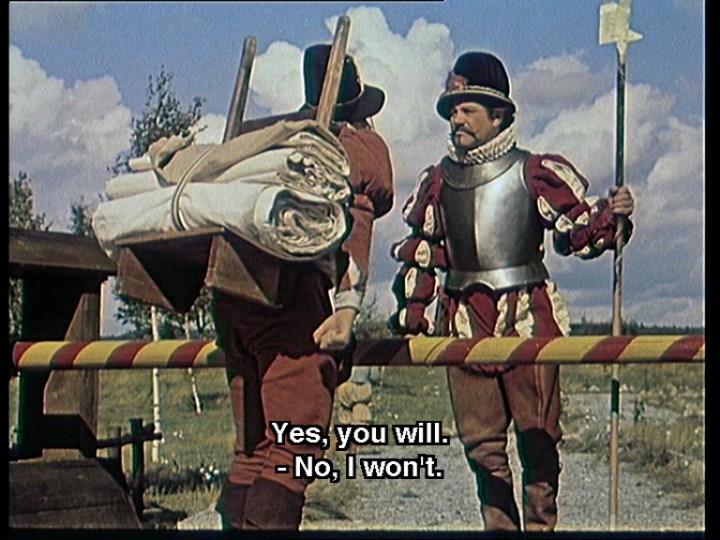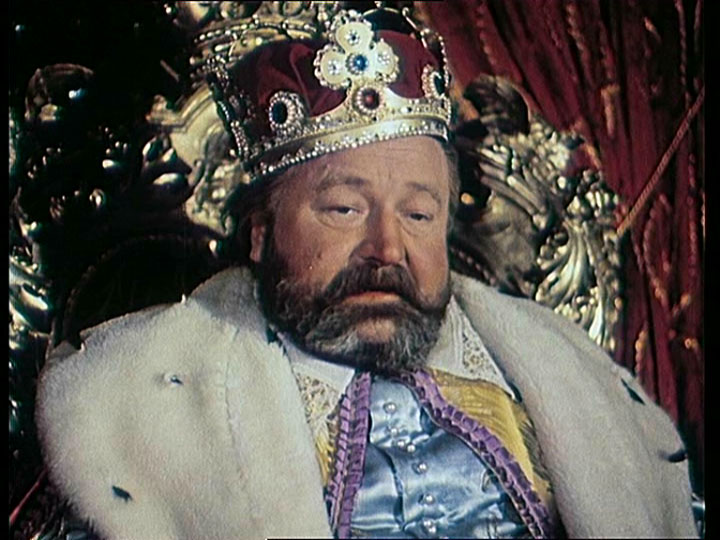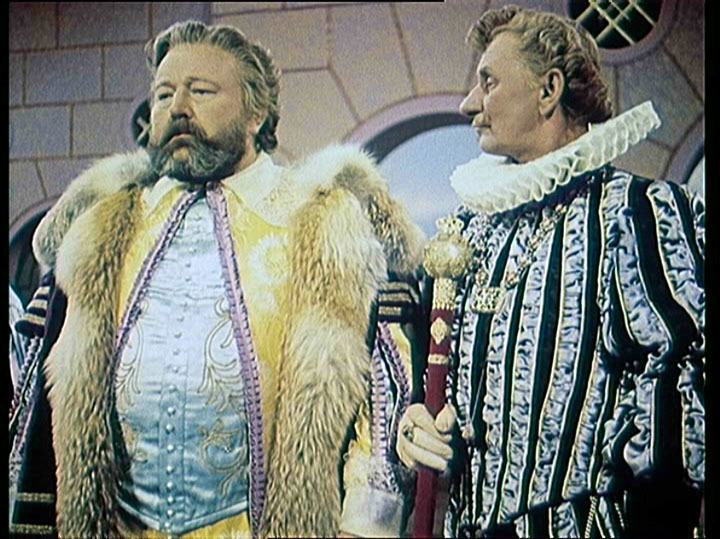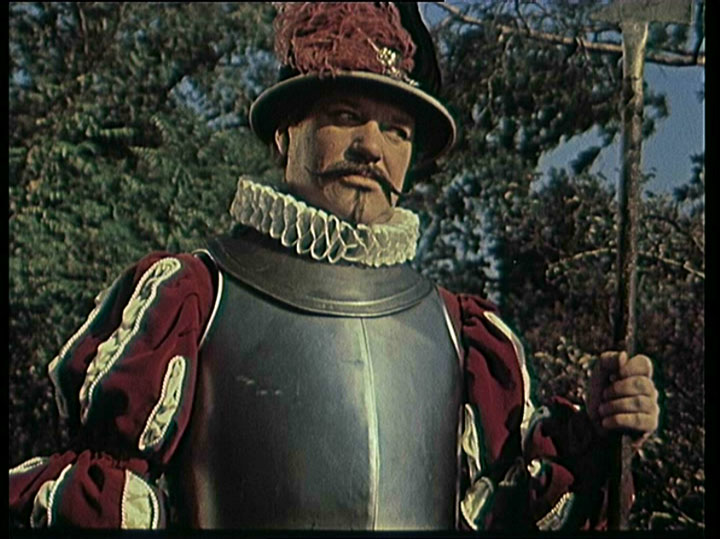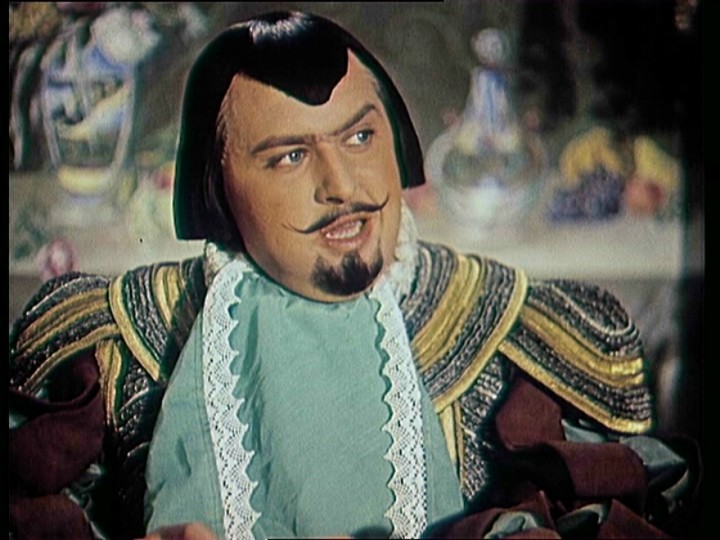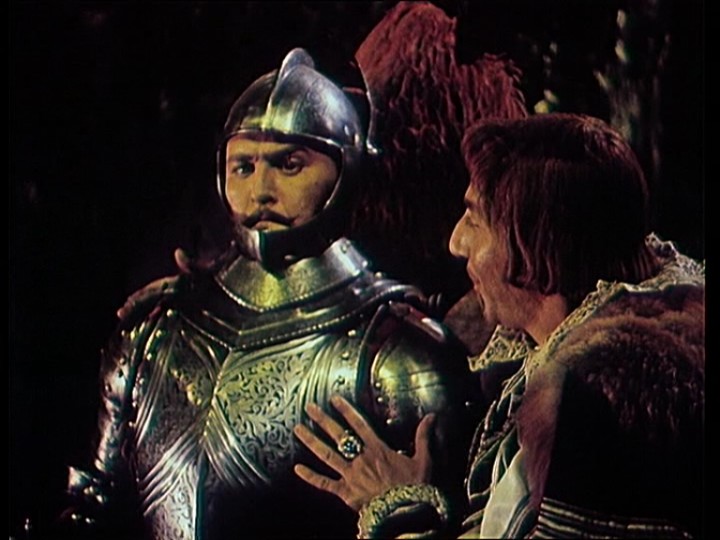![]()

![]()

(aka "Once Upon a Time There Was a King..." )
directed
by Borivoj Zeman
Czechoslovakia 1955
The film, as its title suggests, is set in olden times. The
age of beautiful princesses, gawky princes in armour trying to prove their
worth and warm-hearted but foolish kings. The film is loosely based on Sul nad
zlato (Salt over Gold) a fairy-tale most famously reworked by the Czech author
Bozena Nemcova, although she herself is better known for her quintessential
story of Czech village life, Babicka (The Grandmother).
Zeman's story starts as little more than a hammed up version of Shakespeare's
King Lear. The conceited king (played by Jan Werich, who also contributed to
the screenplay) asks his three unmarried daughters how much they love him.
Zpivanka and Drahomira offer rhapsodic and materially-based comparisons of
their love for him. However, Maruska - the film's Cordelia - is not nearly as
snooty as her sisters. She wears simple clothes and prefers hanging around in
the kitchen with the servants, getting stuck in with the cooking. She says
that she loves him as much as salt. It's not so much an act of defiance
against the sycophancy of her sisters, but more her genuine heart-felt belief
that salt is the most important thing there is and that it is loved and needed
by everyone in the world.
At this juncture, it might be worth digressing to point out that the Czech
diet is, by most standards, lethally high in salt. Indeed, the use of salt in
cooking has almost a religious fervour to it, with salt seen, like bread, as a
staple of the kitchen of a good stable nuclear family. The suggestion that
salt might be bad for you to a Czech, therefore, veers on being an insult to
the primacy of the family in everyday life. A lack of salt is so
incomprehensible to Czechs that one of their most common phrases analogous to
the English concepts of "bland" or "insipid" is "neslany, nemastny", which
literally translates as "not salty, not fatty".
Back to the plot: enraged by his daughter's comparison of him to something so
common, the king not only banishes her from the castle but also seeks to
eradicate all the salt in his kingdom. The court are less than impressed at
his attempts to impose salt-free cooking on them and his subjects furious at
having to hand in all their salt for destruction.
Meanwhile, Maruska teams up with a kindly old woman, who, as well as being the
incarnation of every Czech's grandmother, also happens to have magical powers.
Maruska and the grandmother use the powers to cause manic mayhem back in the
castle.
Like all good fairy-tales, the story ends happily.
Byl jednou jeden kral might at first seem like an unusual candidate to achieve
mythic status in Czech popular culture. It has done so for a number of
reasons, some of which relate to the era in which the film was produced. In
1955, when the film was released, Communism under Novotny was under full swing
and Stalinism was still the order of the day in then Czechoslovakia, despite
the death of the Russian dictator himself two years earlier. Byl jednou jeden
kral managed to strike a balance that few Communist-era films managed. It
appeased the Communist censors, and thus was allowed to be distributed, whilst
still providing the audiences with what they wanted.
Byl jednou jeden kral was an escape from the dull, harsh exterior of life at
that time. The films success may well be tied up with it being in colour, a
far cry from the monochrome world of worker's overalls and tower-blocks which
was being constructed at the time. There is also a nostalgia for olden times
and the film harks back to medieval times when the Czech lands were a force to
be reckoned with and certainly not to pushed around by outsiders imposing
alien ideologies.
Moreover, life in the film, although a series of crazy capers, is
comparatively idyllic and rooted in the kind of Czech rusticism that Socialism
was eager to destroy in the name of progress. To console the censors, the
royalty get a good ribbing: the princes who come to try and marry the
princesses are oafish, corrupt and ignorant, the king is a buffoon and
Maruska's materialistic sisters are most dislikeably ostentatious. Such
caricatures did nothing to dent the enthusiasm of Czech audiences, who saw
them not as Communist propaganda but as essential ingredients of any good
fairy-tale.
The film abounds in interpretations which could be taken different ways by
Communists and non-Communists alike. To give just one example, when the
princes get dumped in favour of some local talent, the authorities could
interpret the action as showing the superiority of the working classes over
the parasitic royalty. The general audiences, however, could view it
differently, seeing the successful suitors as winning because of their earthy
common-sense, a frequent, if not essential, virtue in fairy-tales.
Furthermore, they could see the amorous victory as being due to the lucky lads
being Czech, as opposed to the princes who represent foreign powers with not
entirely friendly intentions.
Indeed the theme of Czechness runs all the way through Byl jednou jeden kral,
although the country is never identified as the Czech lands or any of its
other manifestations. Anyone wanting a basic introduction to Czech folk
cliches could do worse than to watch this film. Its root in traditional family
values makes the film reassuring and heart-warming, which of course makes it
ideal Christmas viewing.
Perhaps the biggest reason for its success, though, is the importance of the
fairy-tale (or pohadka, as it is known) as a genre in Czech Republic. The
Czechs take their fairy-tales far more seriously than most and fairy-tales are
a far more prominent part of children's reading than in Western Europe. This
carries over into film and Nemcova fairy-tales have been the inspiration of
several other Czech films, the most recent one dating from 1994.
Moreover, Jan Werich and Vlasta Burian are in fact major figures in Czech
cultural history. They shot to fame as dadaists and in a post-war climate
which was less well suited to the avant garde they became champions of comic
and folk genres. Werich's post-war running of the Liberated Theatre had an
influence on Vaclav Havel, who at the time worked there as a youthful stage
hand and Werich is noted as a writer and raconteur, as much as he is as an
actor.
In Prague you can even visit the Jan Werich museum. Perhaps, he would be
better known to Anglo-American audiences if he hadn't fallen ill during the
filming of the James Bond movie You Only Live Twice, in which he was
originally cast to play the archetypal baddie, Blofeld.
Byl jednou jeden kral has, therefore, remained close to the hearts of Czechs.
A contemporary poll - at the Czech Movie Heaven website, which allows surfers
to cast their vote on hundreds of Czech films - records a whopping 9/10 rating
for Byl jednou jeden kral, higher than more-internationally famous Czech
classics, such as Ostre sledovane vlaky (Closely Observed Trains, 1966) and
Hori, ma panenko (The Firemen's Ball, 1967).
Andrew James Horton - Editor-in-Chief of Kinoeye
Theatrical Release: 1 February 1955 - Czechoslovakia
Reviews More Reviews DVD Reviews
DVD Review: Filmexport Home Video - Region 0 - PAL
Big thanks to Ole Kofoed for the Review!
| DVD Box Cover |
|
CLICK to order from:
|
| Distribution |
Filmexport Home Video Region 0 - PAL |
|
| Runtime | 1:37:20 (4% PAL speedup) | |
| Video |
1.33:1
Original Aspect Ratio |
|
|
NOTE: The Vertical axis represents the bits transferred per second. The Horizontal is the time in minutes. |
||
| Bitrate |
|
|
| Audio | Czech - Dolby Digital (2.0) Mono / Dolby Digital (5.1). | |
| Subtitles | English, Czech for the hearing impaired or None (Extras is NOT subtitled). | |
| Features |
Release Information: Studio: Filmexport Home Video Aspect Ratio:
Edition Details: Chapters 18 |
|
| Comments |
There are quite a lot of
speckles and other small defects like cigarette burns and scratches on
this print. The colors is faded and vacillates in and out occasionally,
but otherwise the picture quality is sharp and detailed with fine grain.
The new 5.1 remix doesn't sound very appropriate. The sound from the front
speakers echoes in the rear, so choose the original mono track which
sounds good with only little background noise. There is a few grammar
faults in the English subtitles but nothing of a serious nature. Unfortunately, there are 2 forced commercials (50 seconds) before the DVD goes into the main menu. If you wish to try a (very funny) classic Czech fairy tale this is a good choice and for a 50 year old color movie I was pleased with this release. Big thanks to Andrew James Horton for the above movie review originally published on Central Europe Review HERE. |
|
DVD Menus
|
|
|
|
|
|
Screen Captures
Subtitle sample
|
|
|
|
|
|
|
|
|
|
|
|
|
|
![]()

![]()
DONATIONS Keep DVDBeaver alive and advertisement free:
Mail cheques, money orders, cash to: or CLICK PayPal logo to donate!
|
Gary Tooze
|
|
Many Thanks...


